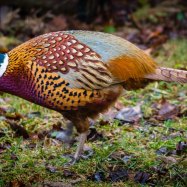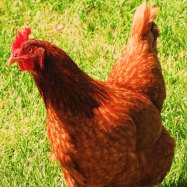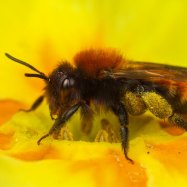
Goshawk
47-69 cm (18-27 in)
The Goshawk, a medium-sized bird of prey with broad wings and a long tail, can be found in various locations around the world. This agile hunter, belonging to the Accipitridae family, measures 47-69 cm in length and has a striking appearance. Keep an eye out for the Goshawk on your next outdoor adventure! #Goshawk #BirdsofPrey #Accipitridae
Animal Details Summary:
Common Name: Goshawk
Kingdom: Animalia
Habitat: Forests, woodlands, and mountainous regions
The Magnificent Goshawk: A Master of the Skies
The animal kingdom is filled with a diverse range of creatures, each with its unique characteristics and abilities. Among the many fascinating animals that inhabit our planet, the goshawk stands out as a true marvel. With its fierce hunting skills, majestic appearance, and impressive range, this bird of prey has captured the imaginations of animal lovers and scientists alike. Join us as we delve into the world of the goshawk and uncover its extraordinary features Goshawk.A Scientific Introduction
The goshawk, scientifically known as Accipiter gentilis, belongs to the Animalia kingdom. It falls under the Phylum Chordata, meaning it possesses a spinal cord, and the Class Aves, indicating that it is a bird. As a member of the Order Accipitriformes, the goshawk is closely related to hawks, eagles, and other birds of prey. Within this order, the goshawk belongs to the Family Accipitridae, which includes over 200 species of birds.Where The Goshawk Calls Home
Goshawks are found in a variety of habitats, including forests, woodlands, and mountainous regions. They are well adapted to different environments, which allows them to thrive in diverse locations. Their natural habitat ranges from Europe to Asia and North America, with different subspecies found in various countries. This wide distribution is further evidence of the versatility and resilience of this magnificent bird.The Hunter’s Diet
As a carnivorous bird, the goshawk’s diet consists mainly of small mammals, birds, and other prey Grapevine Beetle. This bird of prey is a skilled hunter, using its keen eyesight and impressive speed to track and capture its meals. Its sharp talons and powerful beak are formidable weapons, allowing it to take down prey larger than itself with ease. The goshawk is known to ambush its prey, swooping down from above at high speeds, leaving its prey with no chance of escape.Majestic Coloration and Shape
The goshawk has a striking appearance, with a combination of gray, brown, and white feathers covering its body. These colors help it blend into its surroundings, making it an efficient hunter. Its medium-sized body, measuring between 47-69 cm (18-27 in), is perfectly adapted for flight and hunting. The goshawk has broad wings and a long tail, both of which enhance its agility and speed in flight. These features, combined with its sharp vision, make the goshawk a master of the skies.The Goshawk’s Fascinating Life Cycle
As with all species, the goshawk’s life cycle is a remarkable journey that involves various stages. These stages, which include hatching, fledgling, and adulthood, are all critical in the development of this bird. The goshawk’s breeding season is typically from March to July, where it lays a clutch of eggs in a well-hidden nest. Once hatched, the chicks are cared for and fed by their parents until they are strong enough to leave the nest and fend for themselves.The Human and Goshawk Coexistence
Throughout history, humans have had a complicated relationship with birds of prey, including the goshawk. In the past, goshawks were used for falconry, where they were trained to hunt for their human masters. Today, goshawks are highly valued by birdwatchers and nature enthusiasts, who marvel at their impressive hunting skills and grandeur. However, like many species, the goshawk faces threats from human activity, such as habitat destruction and persecution. Conservation efforts are being made to protect this magnificent bird and its habitat, ensuring its continued existence.Goshawks and Technology
Despite being a wild animal, the goshawk has also made its mark in the technological world. In recent years, scientists have used tracking devices to study the movements and behaviors of goshawks. They have also used drones to observe and record goshawk behavior from above, giving us a unique perspective that was impossible to obtain before. These advancements have allowed us to gain a deeper understanding of this remarkable bird and its way of life.Appreciating the Goshawk’s Role in the Ecosystem
Like all animals, the goshawk plays an essential role in the ecosystem. As a predator, it helps to control the population of its prey, creating a balance in the food chain. Additionally, as an indicator species, the presence of goshawks is a sign of a healthy ecosystem. By monitoring and protecting goshawks, we not only safeguard their future, but we also play a part in preserving the delicate balance of nature.The Impact of the Goshawk on Human Culture
Throughout history, goshawks have been a significant inspiration for literature, art, and even sports. Many cultures around the world have revered this bird, recognizing its strength, speed, and grace. The goshawk can be found in ancient mythology, tales, and even stamps and coins. In the sport of falconry, goshawks are highly sought after for their intelligence and hunting abilities. And more recently, the goshawk has even been featured in popular books and films, further solidifying its place in human culture.In Conclusion
From its scientific classification to its extraordinary abilities, the goshawk is a truly remarkable creature. This bird of prey has captured our attention with its impressive hunting skills, majestic appearance, and wide range. As we continue to study and appreciate the goshawk, we also learn more about our natural world and the vital role these birds play in it. So, the next time you see a goshawk flying high in the skies, take a moment to marvel at its beauty and remember the incredible story of this master of the skies.
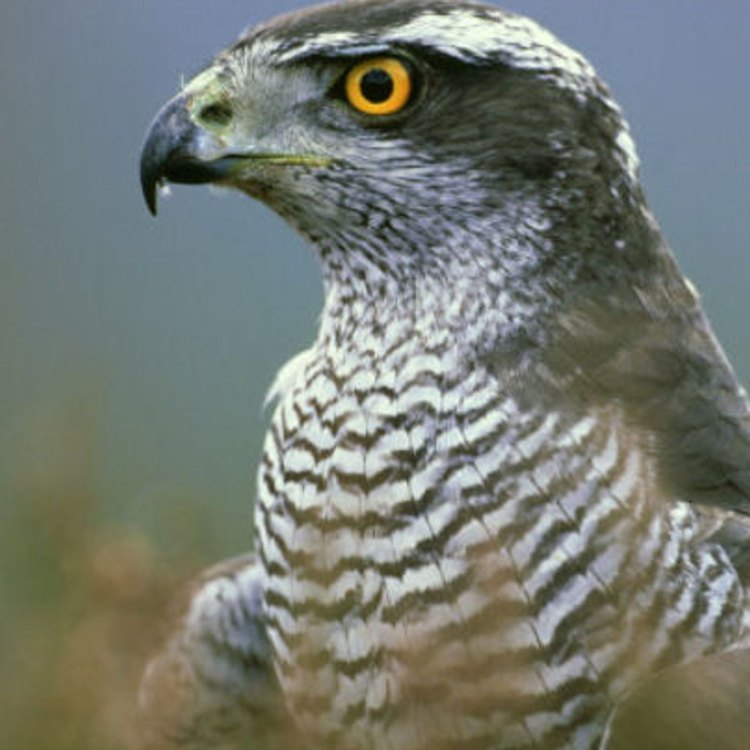
Goshawk
Animal Details Goshawk - Scientific Name: Accipiter gentilis
- Category: Animals G
- Scientific Name: Accipiter gentilis
- Common Name: Goshawk
- Kingdom: Animalia
- Phylum: Chordata
- Class: Aves
- Order: Accipitriformes
- Family: Accipitridae
- Habitat: Forests, woodlands, and mountainous regions
- Feeding Method: Carnivorous
- Geographical Distribution: Europe, Asia, North America
- Country of Origin: Various countries
- Location: Various locations
- Animal Coloration: Gray, brown, and white
- Body Shape: Medium-sized with broad wings and a long tail
- Length: 47-69 cm (18-27 in)
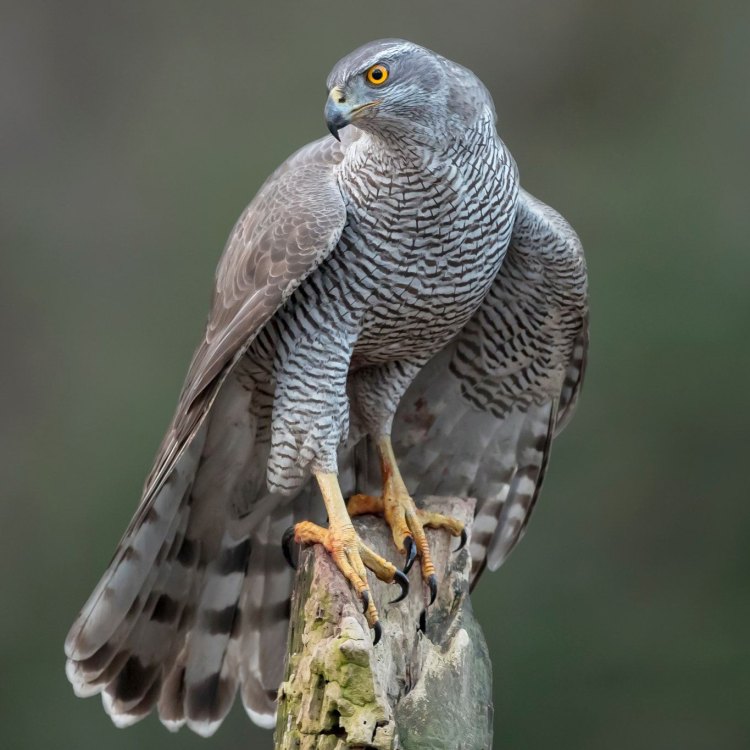
Goshawk
- Adult Size: Large
- Average Lifespan: Up to 20 years
- Reproduction: Sexual
- Reproductive Behavior: Monogamous
- Sound or Call: Loud, piercing calls
- Migration Pattern: Migratory in some populations
- Social Groups: Solitary or small family groups
- Behavior: Agile and stealthy predators
- Threats: Habitat loss, hunting, and pollution
- Conservation Status: Least Concern
- Impact on Ecosystem: Maintains balance in prey populations
- Human Use: Falconry
- Distinctive Features: White, supercilium, fierce facial expression
- Interesting Facts: One of the few bird species known to practice serial monogamy
- Predator: No significant natural predators

Accipiter gentilis
The Mighty Goshawk: Agile Predators of the Skies
The Goshawk, also known as Accipiter gentilis, is a majestic bird of prey found in various regions of North America, Europe, and Asia. With its impressive size and fierce appearance, it has long captured the fascination of human beings. But beyond its outward appearance, the Goshawk possesses unique characteristics and behaviors that make it a remarkable and vital species in the ecosystem.From Pollinator to Predator
The Goshawk is a large bird, with adult sizes ranging from 46 to 69 centimeters (18-27 inches) in length and a wingspan of up to 1 PeaceOfAnimals.Com.3 meters (4 feet). Its broad wings and long tail give it a sleek and agile appearance, making it a skilled hunter in the skies. As a predator, the Goshawk plays a vital role in the ecosystem, keeping other animal populations in check. They primarily feed on small mammals, birds, and occasionally insects, making them an essential part of the food chain.
Monogamous Reproduction
The Goshawk is a sexually reproducing species, with males and females engaging in courtship rituals during mating season. However, what sets them apart is their reproductive behavior of serial monogamy. Unlike other bird species that mate for life, Goshawks form new monogamous pairs each breeding season. This behavior is thought to be an evolutionary advantage, allowing genetic diversity and minimizing the risk of inbreeding.
Avian Language: Loud Calls and Communication
Goshawks are known for their piercing calls, loud enough to be heard from a distance Gooty Sapphire Tarantula. The males have a high-pitched "kak-kak" while females have a lower "bap-bap" call. These calls serve as a mode of communication between individuals and are also used to establish territories and attract mates. Goshawks are solitary birds, but during mating and breeding season, they form small family groups consisting of a male, female, and their offspring.
Migratory Patterns and Habitat
The Goshawk has a vast range, found in various habitats such as forests, woodlands, and mountains. However, their migratory patterns vary in different regions. Some populations are migratory, while others are non-migratory, depending on their location. In North America, Goshawks from the northern regions migrate to the southern part of the continent during winter, while those in Europe stay in their breeding grounds all year round.
The Impact of Human Interference
Despite being listed as a species of "Least Concern" by the International Union for Conservation of Nature (IUCN), the Goshawk still faces various threats, mainly due to human activities. Habitat loss and degradation, caused by urbanization and deforestation, are significant threats to their population. Furthermore, they are also hunted for their feathers and to reduce their impact on game bird populations. Pollution and the use of pesticides also pose a threat to the Goshawk, as these chemicals can accumulate in their prey and affect their health.
A Fascination for Falconry
The Goshawk has long been coveted by falconers for its agility and skill in hunting. Falconry, also known as hawking, is the practice of training and using birds of prey for hunting. The Goshawk's ability to fly swiftly and dive at speeds of up to 60 miles per hour makes it a prized bird used in this ancient sport. However, strict regulations and guidelines are in place to ensure the ethical treatment of these birds in falconry practices.
Distinctive Features: Intimidating and Beautiful
The Goshawk's appearance is striking and distinctive, with its slate grey upper body and white underparts. It also has a conspicuous white supercilium, a tuft of feathers above each eye, giving it a fierce facial expression. These features, combined with its agile movements, make it an intimidating predator in the skies. The Goshawk's strong talons and sharp beak allow it to catch and dispatch its prey with ease.
Interesting Facts about the Goshawk
Despite being popularly known as a fierce predator, there is more to the Goshawk than meets the eye. Here are some interesting facts about this fascinating bird:
• The Goshawk is one of the few bird species known to practice serial monogamy, changing mates each breeding season.
• Goshawks have excellent eyesight, with the ability to spot prey from a distance of up to 1 kilometer (0.6 miles) away.
• They have a third, inner eyelid called the nictitating membrane, which serves as protection while flying and hunting.
• Goshawks have no significant natural predators, but their eggs and young are vulnerable to larger birds of prey such as golden eagles and great horned owls.
• Falconry was initially practiced using Goshawks during the medieval period, and they are still highly valued birds among falconers today.
A Balance in the Ecosystem
The Goshawk plays a crucial role in maintaining balance in prey populations, preventing overpopulation of certain species. Its presence in the ecosystem ensures that other animal populations do not overgraze and destroy habitats, as well as keeping prey populations in check to prevent overconsumption of resources.
Conservation Efforts and Conclusion
While the Goshawk may still be considered a species of "Least Concern," it is vital to continue monitoring and conserving their populations to prevent any decline in the future. Some conservation efforts include preserving and restoring their habitats, implementing strict hunting regulations, and raising awareness about the importance of these birds in the ecosystem. As humans, it is our responsibility to coexist with these magnificent creatures and ensure their survival for generations to come.
In conclusion, the Goshawk is an impressive and vital species in the ecosystem. From its distinctive features and behaviors to its role in maintaining balance, it is clear that the Goshawk is more than just a fierce predator. It is a testament to the beauty and complexity of nature and a reminder for us to cherish and protect all species, big and small. So the next time you catch a glimpse of this magnificent bird of prey soaring in the skies, take a moment to appreciate its beauty and importance.
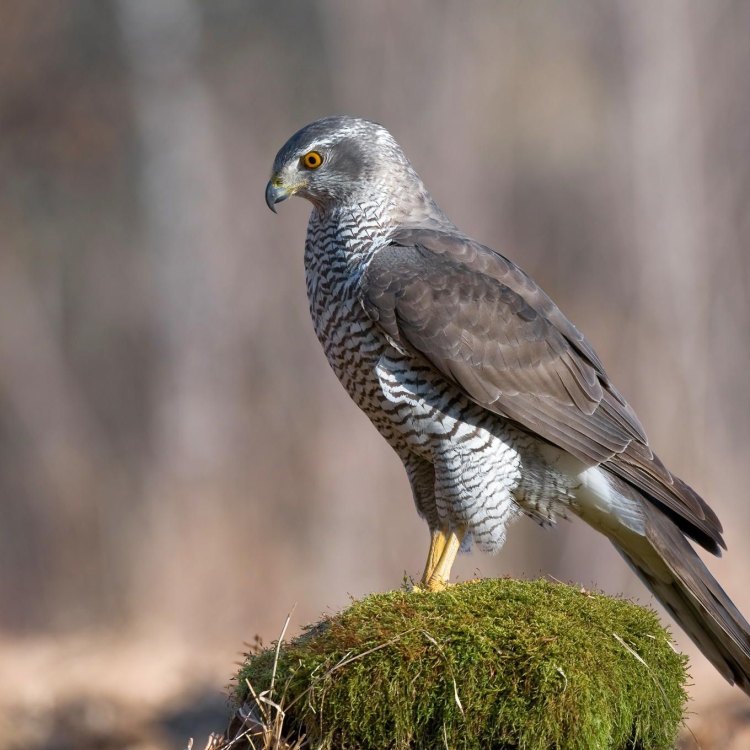
The Magnificent Goshawk: A Master of the Skies
Disclaimer: The content provided is for informational purposes only. We cannot guarantee the accuracy of the information on this page 100%. All information provided here may change without prior notice.

